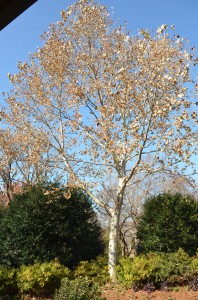Mexican Sycamore (Platanus mexicana) is a fast growing deciduous tree hardy in Northeast Mexico (USDA hardiness zones 7 -10) where it inhabits soils that are semi-arid and subject to periodic flooding. Summer leaves are medium-sized, only 8-inches wide. When leaves fall away in autumn its beautiful chalky white bark is a winter asset. The bark peels off in thin strips and eventually becomes a maintenance chore as the tree develops in size.
This large tree grows at a torrid pace, 50-80 feet tall and 30-40 feet wide, with a very aggressive root system. A 10- year old specimen at the Dallas Arboretum was already 25 feet high and 15 feet wide under regular irrigation. Susan Morgan, Dallas, TX horticulturist, reports that Mexican sycamore has become a favorite with arboretum staff. Roots tolerate periodic flooding. It is highly resistant to leaf scorch compared to American sycamore (P. occidentalis).
Large palmate leaves are silvery above and silvery and fuzzy underneath. Tree is monecious, with male and female flowers separated on the same tree. Sycamores are often pollinated by wind. Female flowers will develop round bristly balls which many people call “gumballs”. An established tree exhibits exceptional drought tolerance. The arboretum trees were grown from seed.
Fall leaf color is quite variable from one location to the next as well as environmental conditions during the growing year. Under ideal rainfall and soil moisture leaves take on a rich golden color. This south of the border species adapts to alkaline soils, an unusual trait for sycamore.


 Posted in
Posted in 
